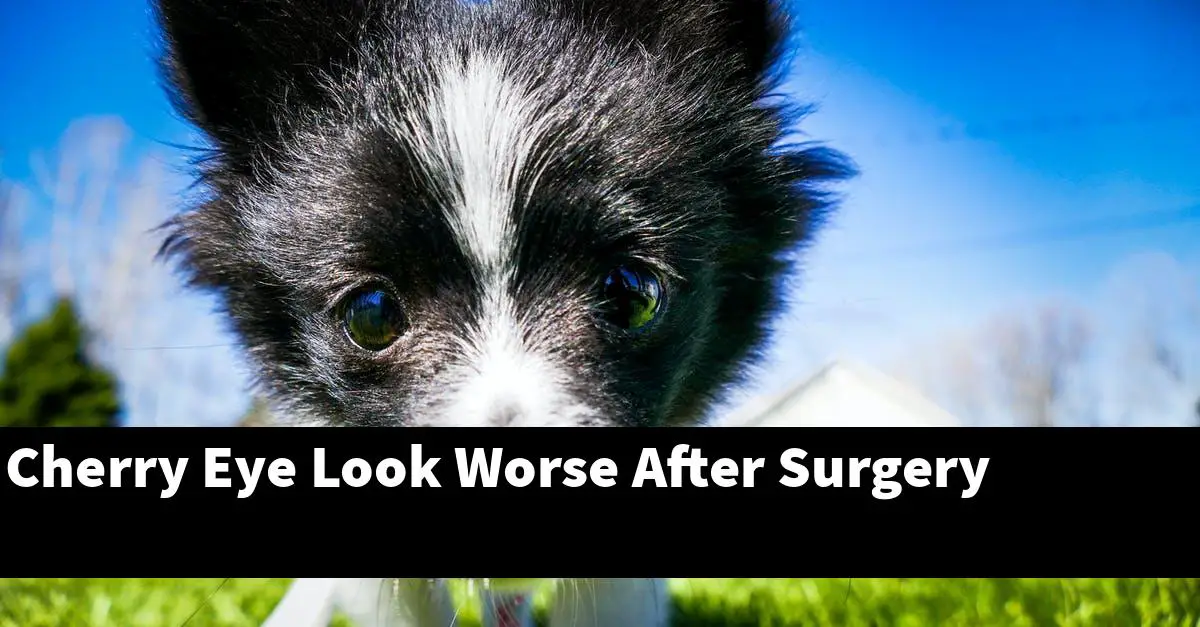This is because the third eyelid, or nictitating membrane, covers the eye more completely after surgery. The cherry eye is a result of the prolapse of the gland of the third eyelid.
Cherry eye is a condition where the tear gland prolapses, or pops out, from its normal position in the eye. It can occur in one or both eyes. Surgery is the most common treatment for cherry eye.
Table of Contents
What are the chances of cherry eye coming back after surgery?
There are several factors that contribute to the chances of cherry eye coming back after surgery. The most important factor is the type of surgery that is performed. If a total conjunctival sac replacement is performed, the chances of recurrence are very low. However, if a partial conjunctival sac removal is performed, the chances of recurrence are much higher.
Another important factor is the age of the dog. Puppies are much more likely to experience recurrence than adult dogs. This is because the tissue around the eye is still growing and developing, and is therefore more prone to injury and inflammation.
Finally, the overall health of the dog also plays a role. Dogs who are immunocompromised or have other health problems are more likely to experience recurrence than healthy dogs.
If you are concerned about the chances of cherry eye coming back after surgery, talk to your veterinarian. They will be able to discuss the risks and benefits of the different types of surgery and help you choose the best option for your dog.
Is it normal for cherry eye to look worse after surgery?
Cherry eye is a condition that results in the prolapse, or bulging, of the third eyelid gland. This gland is responsible for producing tears, and when it prolapses, it can cause the eye to appear red and irritated. Surgery is the most effective treatment for cherry eye, and while the eye may look worse immediately after surgery, this is typically just due to swelling and bruising. The eye should gradually improve over the course of a few weeks.
How long does it take for cherry eye to heal after surgery?
Cherry eye refers to a prolapse of the gland of the third eyelid. This is a condition that is seen more often in dogs than in cats, and is more common in certain breeds, such as the Boston Terrier, Bulldogs, and Cocker Spaniels. Treatment of cherry eye typically involves surgery to reposition the gland.
The surgery is typically fairly straightforward and is often performed as an outpatient procedure. After the surgery, it is important to keep the eye clean and protected. Most dogs will need to wear an Elizabethan collar (cone) to prevent them from rubbing or scratching at the eye.
The recovery period from surgery is typically short, and most dogs will start to show improvement within a few days. The gland will usually return to its normal position within two to three weeks. In some cases, however, the gland may not return to its normal position and may require a second surgery.
Are there any complications that can occur after cherry eye surgery?
After cherry eye surgery, there are a few potential complications that could occur. The most common complication is that the tear duct could become blocked, which can cause the eye to water excessively. Additionally, there is a small risk of infection or bleeding. In rare cases, the surgery may not be successful in correcting the cherry eye.
What should cherry eye look like after surgery?
In general, cherry eye looks like a small, round, red or pink mass on the surface of the eye. After surgery, the mass should be significantly smaller and less conspicuous. The incision site may be visible, but should be healing well.
How long does it take for cherry eye to heal after surgery?
Cherry eye is a condition that affects dogs and can cause the third eyelid, or nictitating membrane, to prolapse and become visible. Surgery is the only way to correct this condition, and it is typically a relatively straightforward and low-risk procedure. Recovery from cherry eye surgery is usually fairly quick, with most dogs being able to return to their normal activities within a week or two.
What happens if cherry eye surgery doesn’t work?
Cherry eye surgery is a procedure that is performed to correct a deformity of the tear gland in the eye. The tear gland is responsible for producing tears, and when it is not functioning properly, the eye does not produce enough tears. This can cause the eye to become dry and irritated, and can lead to infections. If cherry eye surgery does not correct the problem, the eye may continue to experience these symptoms.
How long does it take a dog’s eye to heal after surgery?
The healing process after any surgery is different for each animal, and depends on many factors such as the type of surgery, the age and health of the animal, and the animal’s natural ability to heal. However, in general, it takes approximately two to four weeks for a dog’s eye to heal after surgery. The first few days after surgery are typically the most critical, and it is important to make sure that your dog is kept calm and quiet during this time to allow for proper healing.
Summary
:
Cherry eye is a condition where the tear gland prolapses, or pops out, from its normal position in the eye. It can occur in one or both eyes. Surgery is the most common treatment for cherry eye, and the chances of recurrence are low if a total conjunctival sac replacement is performed. However, if a partial conjunctival sac removal is performed, the chances of recurrence are much higher.


